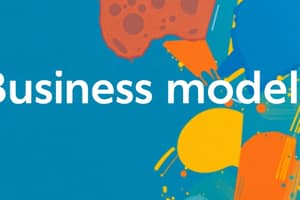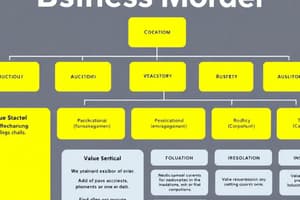Podcast
Questions and Answers
What is a business model?
What is a business model?
A business model describes how an organization creates value, delivers it to customers, and monetizes that value.
What does a business model not include?
What does a business model not include?
- A business plan
- An isolated pricing plan
- A competitive strategy
- All of the above (correct)
What is the Business Model Canvas?
What is the Business Model Canvas?
A framework for developing a business model that helps design submodels and components.
What are the two key elements to assess the viability of a business model?
What are the two key elements to assess the viability of a business model?
Which of the following is NOT a driver of revenues?
Which of the following is NOT a driver of revenues?
Match the following components with their descriptions:
Match the following components with their descriptions:
What is a target customer segment?
What is a target customer segment?
A business model must be scalable in order to be viable.
A business model must be scalable in order to be viable.
What is a value capturing model?
What is a value capturing model?
Which are examples of multicomponent pricing models?
Which are examples of multicomponent pricing models?
Study Notes
Introduction to Business Models
- A business model defines how an organization creates, delivers, and monetizes value.
- Key components include parties, relationships, and flows of goods, money, and information.
- Not classified as a business model: benefits alone, isolated pricing plans, financial models, competitive strategies, or business plans.
- The Business Model Canvas serves as a standard framework for developing and designing business models.
Characteristics of a Business Model
- A viable business model is assessed by its generated value-add, categorized into:
- Effectiveness: Offers greater benefits than competitors.
- Efficiency: Provides existing offerings at lower costs.
- Understanding revenue and cost drivers:
- Revenue Sources: Purchase/sale, pricing model, and network effects.
- Cost Factors: Fixed costs (assets, employees) and variable costs (customer acquisition, production).
- Scalability allows growth related to financing, but viability doesn’t depend solely on scalability.
Risk Factors and Business-Specific Risks
- Important to consider unique risks associated with various business models.
- Capital requirements include:
- Funds for a business model to become self-sustaining.
- Funds for accelerating growth from one trajectory to a more aggressive one.
Value Capturing and Value Creation Models
- The value capturing model explains relationships with customers and the monetization process.
- Distinction made between customers and their end-users to enhance value capture.
Customer Relationships and Revenue Streams
- Key inquiries include identifying the customer base and understanding revenue flows:
- Determine customer characteristics and motivations.
- Analyze revenue flow types: one-time, periodic, or recurring payments.
- Consider terms of payment and the role of intermediaries.
Target Customer Segments
- Identification of target customer segments is crucial, impacting the dynamics and stability of a business model.
Analysis of Customer Relationships
- Characterize value capturing by examining customer relationships across their lifecycle.
Pricing Models
- Establish the price customers pay, essential for optimizing business income.
Examples of Multicomponent Pricing Models
- Multicomponent pricing captures value from multiple delivery aspects:
- Notable examples include printers and ink cartridges, coffee machines and capsules, cars and spare parts, and razors and blades.
- Systems and service models such as cars, industrial machines, and software also exemplify this pricing strategy.
Studying That Suits You
Use AI to generate personalized quizzes and flashcards to suit your learning preferences.
Description
This quiz covers the key concepts and definitions from Chapters 1 to 6 of Business Models. It introduces what a business model is, its role in creating and delivering value, and the relationships involved in monetizing that value. Test your understanding of these foundational ideas in business model theory.




